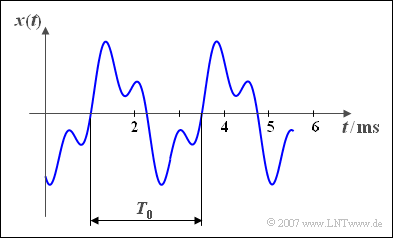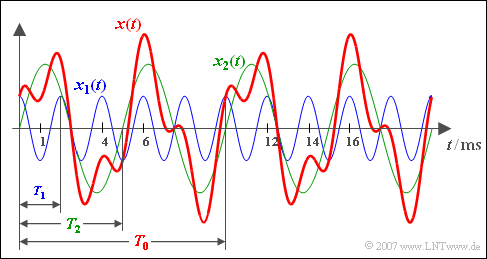Difference between revisions of "Signal Representation/General Description"
| Line 107: | Line 107: | ||
==Exercises for the Chapter== | ==Exercises for the Chapter== | ||
<br> | <br> | ||
| − | [[ | + | [[Exercise_2.1:_Rectifying|Exercise 2.1: Rectifying]] |
| − | [[Aufgaben: | + | [[Aufgaben:Exercise_2.1Z:_Summing_Signal|Exercise 2.1Z: Summing Signal]] |
Revision as of 18:03, 1 November 2020
Contents
# OVERVIEW OF THE SECOND MAIN CHAPTER #
In this chapter periodic signals are considered and described mathematically in the time and frequency domain.
This chapter contains in detail:
- Some basic terms like period duration, fundamental frequency and circular frequency,
- the properties of a equal signal as a boundary case of a periodic signal,
- the definition and interpretation of the Dirac function,
- the spectral representation of a equal signal or a equal signal component,
- the time– and frequency representation of harmonic oscillations, and finally
- the application of Fourier series for spectral analysis of periodic signals.
Further information on the topic as well as tasks, simulations and programming exercises can be found in
- Chapter 6: Linear and Time Invariant Systems (Program lzi)
of the lab „Simulation Methods in Communication Engineering”. This former LNT course at the TU Munich is based on
- the educational software package LNTsim ⇒ Link points to the ZIP version of the program, and
- this lab instruction ⇒ Link refers to the PDF version of ; chapter 6: page 99-118.
Features and Applications
Periodic signals are of great importance for communications engineering:
- They belong to the class of deterministic signals, whose time function can be specified in analytical form.
- Their signal path is thus known for all times $t$ and can be clearly predicted for the future.
- They are therefore never information-carrying signals.
Nevertheless, periodic signals are often also required in communications engineering, for example
- for modulation and demodulation in carrier frequency systems,
- for synchronization and clock regeneration in digital systems,
- as test– and test signals during system implementation.
$\text{Example 1:}$ The oscilloscope image shows two typical representatives of periodic signals:
- above a cosine pulse,
- below a triangle pulse.
As can be seen from the displayed settings, the period duration of both signals is one millisecond and the amplitude one volt.
Definition and Parameters
Before we turn to the signal parameters of a periodic signal, the term „periodicity” shall be clearly defined:
$\text{Definition:}$ A periodic signal $x(t)$ ; is present if for all arbitrary values of $t$ and all integer values of $i$ with an appropriate $T_{0}$ applies:
- $$x(t+i\cdot T_{0}) = x(t).$$
This results in the following parameters:
- The Period duration $T_{0}$ indicates the smallest possible value, which satisfies the above equation.
- The ‘Fundamental frequency' $f_{0} = 1/T_{0}$ describes the number of periods per time unit (mostly per second).
- The unit "1/s" is also called "Hz", named after the German physicist Heinrich Hertz.
- The ‘fundamental angular frequency' $\omega_{0}$ represents the angular rotation per second, usually given in radians.
- In contrast to the basic frequency, the unit "Hz" is not common here, but "1/s". The following equation applies:
- $$\omega_{0}=2\pi f_{0} = {2\pi}/{T_{0}}.$$
$\text{Example 2:}$ Here, a periodic time signal is shown:
- The period duration is $T_{0} = 2.5 \ \rm ms$.
- From this the fundamental frequency $f_0 = 400 \ \rm Hz$ is calculated.
- The fundamental circular frequency results to nbsp;$\omega_{0}=2513 \ \rm 1/s.$
Resulting Period Duration
If a signal $x(t)$ consists of the sum of two periodic signals $x_{1}(t)$ and $x_{2}(t)$ with the period durations $T_{1}$ or $T_{2}$, the resulting period duration of the sum signal is the smallest common multiple of $T_{1}$ and $T_{2}$.
- This statement applies independently of the amplitude and phase relations.
- On the other hand, if $T_{1}$ and $T_{2}$ don't have a rational common multiple $($Example: $T_{2} = \pi \cdot T_{1})$, then the sum signal $x(t)$ in contrast to its two components $x_{1}(t)$ and $x_{2}(t)$ is not periodic.
$\text{Example 3:}$ Here, a cosine-shaped signal $x_{1}(t)$ with the period duration $T_{1} = 2\; {\rm ms}$ (blue signal course) is added with a sinusoidal signal $x_{2}(t)$ with the period duration $T_{2} = 5\; {\rm ms}$ and twice the amplitude (green curve).
- The (red) sum signal $x(t) = x_{1}(t) + x_{2}(t)$ then shows the resulting period duration $T_{0} = 10\; {\rm ms}$ shows ⇒ fundamental frequency $f_{0} = 100\; {\rm Hz}$.
- The frequency $f_{0}$ itself is not contained in $x(t)$ only integer multiples of it, namely $f_{1} = 500\; {\rm Hz}$ and $f_{2} = 200\; {\rm Hz}$.
With the interactive applet Periodendauer periodischer Signale the resulting period of two harmonic oscillations can be determined.
Exercises for the Chapter


